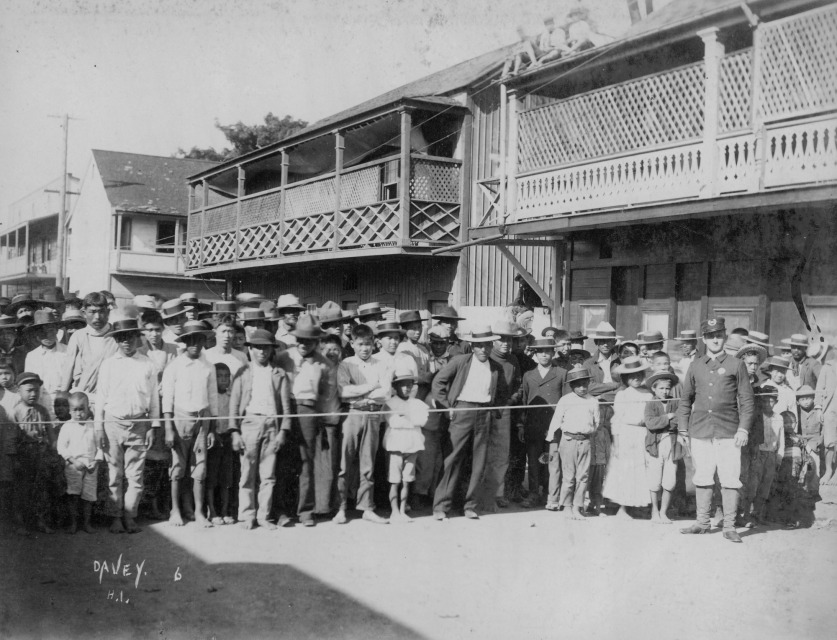Invasive Species » Unit 2: Invasive Species Impacts: Why Care? » Activity 4: Plagues: Past and Present
Materials & Setup
In Advance
- Order Glo Germ™ powder and ultraviolet light for Class Period Two. (Glo Germ™ powder and light can be purchased from: www.amazon.com and www.glogerm.com. A two-ounce bottle will last several years.)
Optional: Assign parts for the reader’s theater a day or two before class to allow students to practice. Have students read Student Pages “Plague On Our Shores” and highlight their parts.
Class Period One
For each student
- Student Pages “Plague on Our Shores” script and worksheet (pp. 45-53)
Note: If you have extra time, you can assign the script as homework and allow students practice their roles before performing in class. They can bring props and costume elements from home, such as police or firemen’s hats, doctor’s coats, brooms (which can double as rifles), plastic or plush rats, and fire hose.
The slideshow “Bubonic Plague in Honolulu 1899” is included with this curriculum and available for download at www.hoikecurriculum.org. It duplicates much of the information in the “Plague on Our Shores” script but includes historic photos of the events. If you think your students will have a hard time following the script, or want to present the information in a visual format, you can show this slideshow as a precursor to their reader’s theater.
Class Period Two
- Glo Germ™ powder
- Ultraviolet light
- Teacher Copy Master “Symptom Cards” (pp. 43-44)
For each student:
- Student Pages “Disease Diagnosis Chart” (pp. 54-55)
- “Rat Lungworm Disease Fact Sheet” (pp. 57-59)
For each group of students:
- Student Pages “Rat Lungworm Disease Response Strategy” (pp. 56-67)
Instructions
Class Period One
1) Use information provided in the Teacher Background “How Invasive Species Can Endanger Public Health and Safety,” to lead a brief discussion on the topic.
2) Direct students in a reader’s theater performance of “Plague on Our Shores.” Use the Teacher Background “Readers’ Theater Tips” as a guide. Break students into groups of five. Each group will perform one act of the play.
3) Pass out the Student Page “Plague on Our Shores Worksheet” and have the students in the audience to assume a role while listening. They can choose from: ship captain, ship passenger, doctor, epidemiologist, Chinese merchant, Hawaiian landlord, lawyer, fireman, church pastor, schoolteacher, pregnant mother, plague victim, crematorium operator, or other relevant characters. They will discuss their various characters’ reactions to the play at the end of class.
4) In addition to noting their characters’ reactions, instruct students to listen for a) steps the Department of Health took to prevent the spread of the disease, b) what kind of resistance those steps were met with, and c) long-term effects of the bubonic plague outbreak in Hawaii. They will record their answers on the Student Page “Plague on Our Shores Worksheet.”
5) Discuss worksheet answers as a class.
Class Period Two
1) Before class, smear a light coating of Glo Germ ™ powder onto five students’ desks or chairs. (Alternately, apply it to your own hand and choose students to shake hands with.) Do not tell the students. This invisible powder is meant to simulate the slime trail of a slug infected with rat lungworm parasites.
2) Review the material covered in class period one regarding how invasive species can endanger public health.
3) Tell students that members of their class have been infected with imaginary cases of a disease spread by invasive species. They will spend the rest of class working as a team to respond to this public health crisis.
4) Turn the overhead lights off and have students pass their hands under the ultraviolet light. The students with glowing hands are ill. Give the “sick” students symptom cards (Copy Master “Symptom Cards”), which they keep private from the other students. Tell the class that the students became ill after sharing a picnic lunch. At first they thought it was the flu or food poisoning. But when the symptoms didn’t disappear after a day, they suspected something more serious and went to the emergency room. Now it’s up to the class to diagnose their sick classmates and protect the public from an epidemic.
5) Pass out the Student Page “Disease Diagnosis Chart.” Students will take turns asking their “sick” classmates questions from the chart to determine what illness they are all suffering from. By process of elimination, the class will agree on a diagnosis.
6) After the correct diagnosis is made (rat lungworm disease), show the short video on rat lungworm disease. http://animal.discovery.com/tv-shows/monsters-inside-me/videos/the-rat-lungworm.htm
7) Pass out the Student Pages “Rat Lungworm Disease Fact Sheet,” to each student and read aloud together.
8) Break students into 4-5 groups to devise response strategies. Tell them to record their groups’ answers on Student Page “Rat Lungworm Disease Response Strategy.”
9) Go over worksheet answers in class.
Journal Ideas
- Speculate how cultural differences affected the spread of the plague. Might things have been different if the outbreak had started in the missionary or native Hawaiian communities?
- What would be different if an outbreak of plague occurred today?
- Rabies is another example of a disease spread by invasive species. Write a few paragraphs about how life in Hawaiÿi would be different if rabies were present here. If you don’t know what rabies infections are like, ask your classmates, teacher, and friends if they have lived an area with rabid animals.
Assessment Tools
- Participation in reader’s theater and class discussion
- Participation in class activity: disease diagnosis
- “Plague on Our Shores” and “Rat Lungworm Response Strategy” worksheets
- Journal entries
Media Resources
- Slideshow to accompany class one: Bubonic Plague in Honolulu 1899
- Video to accompany class one:

